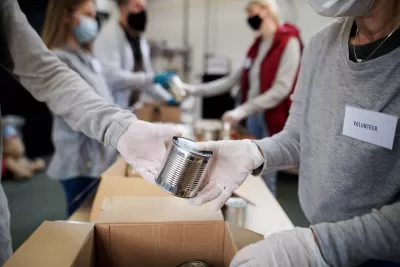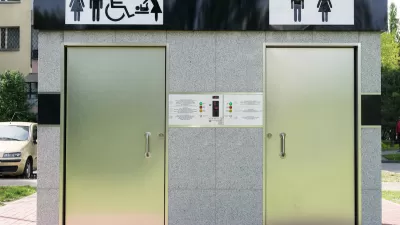Connections with neighbors and local institutions can play an important role in how a community responds to disaster.

When Hurricane Ian hit North Port, Florida last year, residents were trapped in flooded neighborhoods. Rather than waiting for emergency crews, boat owners used their personal craft to rescue stranded neighbors and bring in supplies for those who stayed behind. Last month, when the Gray Fire blocked roads in Washington state, one resident loaded his neighbors onto his pontoon boat and sailed them to safety.
Neighbors who know one another are more likely to help each other before, during, and after a disaster strikes. Most will call this being a good neighbor, but there’s a formal name for it: social capital. Defined as networks that enable collective action, social capital can mean the difference between life and death in a disaster. Fostering social capital is a necessary element of resilience planning because it increases the capacity of residents to respond to and more quickly recover from a disaster.
Innumerable stories have been written about the loss of community, the lack of neighborliness, and the growing atomization of society and culture. These stories decry the impact on crime, quality of life, and economics, but we should also discuss the effect on natural disaster response and recovery.
Low social capital is correlated with lower access to information, such as evacuation orders, as well as reduced access to resources to respond to and recover from a disaster, exacerbating the impacts. As we continue to see population growth in vulnerable areas, conventional approaches to hazard mitigation are insufficient for the challenges our communities face. Planners and emergency responders are recognizing that building social capital must be part of the holistic response to growing threats from natural hazards.
Social capital is grounded in networks, relationships, and trust. In high social capital neighborhoods, people are more likely to receive communication and information that enables them to respond more effectively to a disaster. Additionally, residents will be more likely to return and reinvest in their neighborhoods.
For example, West Street Recovery began as an informal effort to recover from Hurricane Harvey in a Houston neighborhood. Committed residents helped during the immediate aftermath to clean up homes and, over the long term, invested in rebuilding. The informal group became a non-profit that has contributed to response efforts during the COVID-19 pandemic, urban unrest, and Winter Storm Uri.
Finally, the networks and relationships that define social capital can create access to resources that can benefit recovery as well. Connections to civic organizations, local businesses, and local politicians can all create opportunities for investment and assistance in the recovery process. After a disaster, there are enormous demands on these entities. Having connections can make a difference in how much attention a community may receive. It may be an unfortunate fact to acknowledge, but it is sometimes who you know that can make a difference.
If we recognize the importance of social capital in building resilient communities, what is the role of planners in this effort? Social capital cannot be created through top-down initiatives; it must be created at the grassroots level. However, there are practices for creating an environment within which social capital can develop.
One approach is to build more walkable communities. This contributes not just to neighbors knowing one another, which increases the likelihood of assisting one another during a disaster, it also fosters more trust and connection, which means people are more likely to get important news and information to respond to a disaster more effectively.
Too often, the low-income and marginalized communities most impacted by disasters are those least engaged in community decision-making. This also contributes to lower responsiveness to official communication and outreach, leaving these populations less informed about potential disasters. Planners have a responsibility to engage those communities, making every effort to connect and build meaningful relationships. The first step is identifying individuals who can help introduce us to those communities and establish the necessary trust to begin building connections.
It can be done. In Paris, local officials are working to create ‘super neighbors’ through a grassroots effort to build connections at the neighborhood level. The idea is that these informal connections create capacity within the neighborhood to respond during crises such as urban unrest, heat waves, and other disasters. This is especially important in marginalized communities where connections are often lacking and can become the foundation for improving trust and communication.
When we think of preparing for natural disasters, it is easy to overlook the role of community in effective resilience planning. We tend to focus on things like infrastructure, emergency services, and government capacity while overlooking the enormous resources of family, friends, and neighbors. By strengthening neighborhoods, we can create safer, more resilient communities with greater capacity to respond to, and recover from, the growing threat of natural disasters.
About the author
Christopher Holtkamp has been a certified planner since 2006. In 2018, he earned his Ph.D. and became an Assistant Professor of Environmental Planning at the University of Wisconsin River Falls. He brings his professional experience into the classroom, focused on preparing students for successful careers. His courses revolve around issues of sustainability and the role planners play in building sustainable and resilient communities.

Study: Maui’s Plan to Convert Vacation Rentals to Long-Term Housing Could Cause Nearly $1 Billion Economic Loss
The plan would reduce visitor accommodation by 25,% resulting in 1,900 jobs lost.

North Texas Transit Leaders Tout Benefits of TOD for Growing Region
At a summit focused on transit-oriented development, policymakers discussed how North Texas’ expanded light rail system can serve as a tool for economic growth.

Why Should We Subsidize Public Transportation?
Many public transit agencies face financial stress due to rising costs, declining fare revenue, and declining subsidies. Transit advocates must provide a strong business case for increasing public transit funding.

Alabama: Trump Terminates Settlements for Black Communities Harmed By Raw Sewage
Trump deemed the landmark civil rights agreement “illegal DEI and environmental justice policy.”

Dear Tesla Driver: “It’s not You, It’s Him.”
Amidst a booming bumper sticker industry, one writer offers solace to those asking, “Does this car make me look fascist?”

A Visual Celebration of Manhattan’s Chinatown Elder Community, Through Food
Lanterns, cafeteria trays, and community connection take center stage in this stunning photo essay.
Urban Design for Planners 1: Software Tools
This six-course series explores essential urban design concepts using open source software and equips planners with the tools they need to participate fully in the urban design process.
Planning for Universal Design
Learn the tools for implementing Universal Design in planning regulations.
City of Santa Clarita
Ascent Environmental
Institute for Housing and Urban Development Studies (IHS)
City of Grandview
Harvard GSD Executive Education
Toledo-Lucas County Plan Commissions
Salt Lake City
NYU Wagner Graduate School of Public Service




























